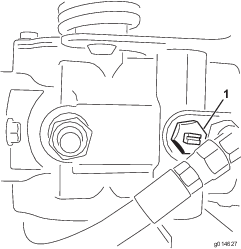| Maintenance Service Interval | Maintenance Procedure |
|---|---|
| Before each use or daily |
|
Introduction
This machine is a ride-on, reel-blade lawn mower intended to be used by professional, hired operators in commercial applications. It is primarily designed for cutting grass on well-maintained lawns in parks, golf courses, sports fields, and on commercial grounds. It is not designed for cutting brush, mowing grass and other growth alongside highways, or for agricultural uses.
Important: To maximize the safety, performance, and proper operation of this machine, carefully read and fully understand the contents of this Operator’s Manual. Failing to follow these operating instructions or to receive proper training may result in injury. For more information on safe operating practices, including safety tips and training materials, go to www.Toro.com.
Whenever you need service, genuine Toro parts, or additional information, contact an authorized Toro distributor and have the model and serial numbers of your product ready. Figure 1 identifies the location of the model and serial numbers on the product. Write the numbers in the space provided.
Important: With your mobile device, you can scan the QR code on the serial number decal (if equipped) to access warranty, parts, and other product information.
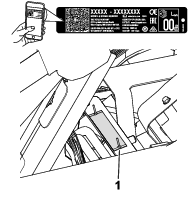
This manual identifies potential hazards and has safety messages identified by the safety-alert symbol (Figure 2), which signals a hazard that may cause serious injury or death if you do not follow the recommended precautions.

This manual uses 2 words to highlight information. Important calls attention to special mechanical information and Note emphasizes general information worthy of special attention.
This product complies with all relevant European directives; for details, please see the separate product specific Declaration of Conformity (DOC) sheet.
Warning
CALIFORNIA
Proposition 65 Warning
Diesel engine exhaust and some of its constituents are known to the State of California to cause cancer, birth defects, and other reproductive harm.
This spark ignition system complies with Canadian ICES-002
It is a violation of California Public Resource Code Section 4442 or 4443 to use or operate the engine on any forest-covered, brush-covered, or grass-covered land unless the engine is equipped with a spark arrester, as defined in Section 4442, maintained in effective working order or the engine is constructed, equipped, and maintained for the prevention of fire.
Safety
This machine has been designed in accordance with EN ISO 5395:2013 and ANSI B71.4-2017 and meets these standards when you add the appropriate weight kit, CE decals, and guard kit.
General Safety
This product is capable of amputating hands and feet and of throwing objects. Always follow all safety instructions to avoid serious personal injury.
Using this product for purposes other than its intended use could prove dangerous to you and bystanders.
-
Read and understand the contents of this Operator’s Manual before starting the engine.
-
Do not put your hands or feet near moving components of the machine.
-
Do not operate the machine without all guards and other safety protective devices in place and working on the machine.
-
Keep clear of any discharge opening. Keep bystanders and pets a safe distance away from the machine.
-
Keep children out of the operating area. Never allow children to operate the machine.
-
Stop the machine and shut off the engine before servicing, fueling, or unclogging the machine.
Improperly using or maintaining this machine can result in injury. To reduce the potential for injury, comply with these safety instructions and always pay attention to the safety-alert symbol, which means Caution, Warning, or Danger—personal safety instruction. Failure to comply with these instructions may result in personal injury or death.
You can find additional safety information where needed throughout this Operator’s Manual.
Safety and Instructional Decals
 |
Safety decals and instructions are easily visible to the operator and are located near any area of potential danger. Replace any decal that is damaged or missing. |
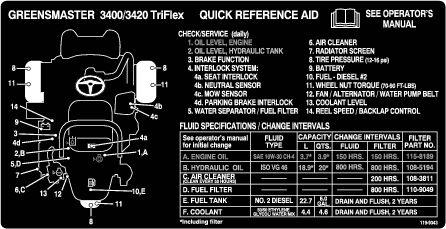
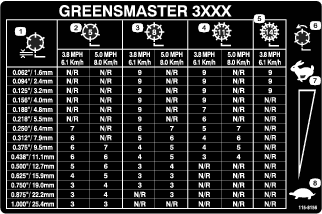



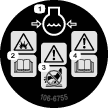

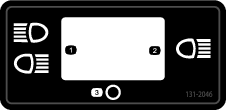
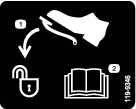

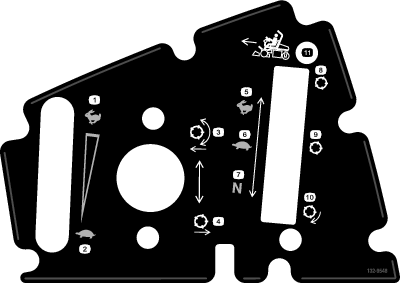
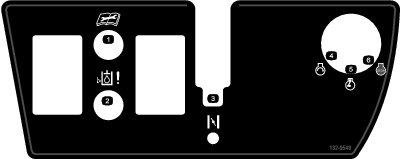
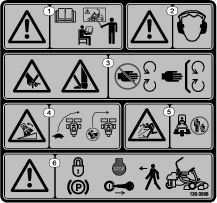
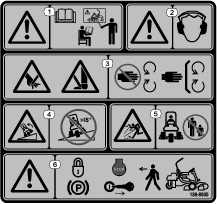
Setup
Installing the Roll Bar
Parts needed for this procedure:
| Roll bar | 1 |
| Bolt (1/2 x 3-3/4 inches) | 4 |
| Flange nut (1/2 inch) | 4 |
-
Remove the top crate support from the crate.
-
Remove the roll bar from the crate.
-
Use 4 bolts (1/2 x 3-3/4 inches) and 4 flange nuts (1/2 inch) to install the roll bar into the ROPS brackets on each side of the machine as shown in Figure 3.

-
Torque the fasteners to 136 to 149 N∙m (100 to 110 ft-lb).
Installing the Seat
Parts needed for this procedure:
| Seat-completion kit | 1 |
Acquire your desired seat kit from your distributor and install it to the machine; refer to the kit Installation Instructions.
Installing the Steering Wheel
Parts needed for this procedure:
| Steering wheel | 1 |
| Locknut (1-1/2 inches) | 1 |
| Washer | 1 |
| Steering-wheel cap | 1 |
-
Slide the steering wheel onto the steering shaft (Figure 4).

-
Slide the washer onto the steering shaft (Figure 4).
-
Secure the steering wheel to the shaft with a locknut and tighten it to 27 to 35 N∙m (20 to 26 ft-lb) (Figure 4).
-
Install the cap to the steering wheel and secure it with 6 bolts (Figure 4).
Activating and Charging the Battery
Use only electrolyte (1.265 specific gravity) to fill the battery initially.
Warning
CALIFORNIA
Proposition 65 Warning
Use of this product may cause exposure to chemicals known to the State of California to cause cancer, birth defects, or other reproductive harm.
Warning
Battery terminals or metal tools could short against metal machine components, causing sparks. Sparks can cause the battery gasses to explode, resulting in personal injury.
-
When removing or installing the battery, do not allow the battery terminals to touch any metal parts of the machine.
-
Do not allow metal tools to short between the battery terminals and metal parts of the machine.
-
Remove the fasteners and battery clamp and lift out the battery.
Important: Do not add electrolyte while the battery is in the machine. You could spill it, causing corrosion.
-
Clean the top of the battery and remove the vent caps (Figure 5).
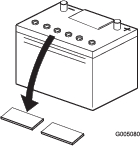
-
Carefully fill each cell with electrolyte until the plates are covered with about 6 mm (1/4 inch) of fluid (Figure 6).

-
Allow approximately 20 to 30 minutes for the electrolyte to soak into the plates. Fill as necessary to bring the electrolyte to within about 6 mm (1/4 inch) of the bottom of the fill well (Figure 6).
-
Connect a 2 to 4 A battery charger to the battery posts. Charge the battery for at least 2 hours at 4 A or for at least 4 hours at 2 A until the specific gravity is 1.250 or higher and the temperature is at least 16°C (60°F) with all cells gassing freely.
Warning
Charging the battery produces gasses that can explode.
Never smoke near the battery and keep sparks and flames away from the battery.
Important: If you do not charge the battery for at least the time specified above, you may reduce the life of the battery.
-
When the battery is charged, disconnect the charger from the electrical outlet and battery posts.
Note: After the battery has been activated, add only distilled water to replace normal loss, although maintenance-free batteries should not require water under normal operating conditions.
Important: Failure to correctly activate the battery may result in battery gassing and/or premature battery failure.
-
Install the vent caps.
-
Place the battery on the battery tray and secure it with the battery clamp and fasteners removed previously.
-
Install the positive cable (red) to the positive (+) terminal and then the negative cable (black) to the negative (–) terminal of the battery and secure them with the bolts and nuts (Figure 7). Slide the rubber boot over the positive terminal to prevent a possible short from occurring.
Warning
Incorrect battery cable routing could damage the tractor and cables, causing sparks. Sparks can cause the battery gasses to explode, resulting in personal injury.
-
Always disconnect the negative (black) battery cable before disconnecting the positive (red) cable.
-
Always connect the positive (red) battery cable before connecting the negative (black) cable.

Installing the Oil Cooler
Parts needed for this procedure:
| Oil Cooler Kit—Greensmaster 3300 Series Traction Unit (Part No. 119-1691 [purchased separately]) |
If you are operating the machine in hot climates, where the ambient temperature is above 29°C (85°F), or using it for heavy-duty use (mowing other than greens, such as fairways or verticutting), install the optional hydraulic oil cooler kit (Part No. 119-1691).
Installing the Grass-Basket Hooks
Parts needed for this procedure:
| Grass-basket hook | 6 |
| Flange bolts | 12 |
Install the 6 grass-basket hooks onto the ends of the suspension-arm bars using the 12 flange bolts (Figure 8).
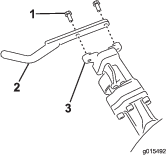
Installing the Cutting Units
Parts needed for this procedure:
| Gauge bar | 1 |
| Cutting unit (obtain from your authorized Toro Distributor) | 3 |
| Grass basket | 3 |
-
Prepare the cutting units for installation; refer to your cutting unit Operator’s Manual.
-
Apply grease to the inside diameter of the drive coupler.
-
Install the cutting units; refer to Installing the Cutting Units.
Adding Rear Weight
Parts needed for this procedure:
| Weight Kit, Part No. 121-6665 (purchase separately) Note: This kit is not required for units with the 3 wheel drive kit installed. | 1 |
This unit complies with EN ISO 5395:2013 and ANSI B71.4-2017 when equipped with Weight Kit, Part No. 121-6665.
Note: If the unit is equipped with a 3-Wheel Drive Kit, additional weight is not required to meet EN ISO 5395:2013 and ANSI B71.4-2017.
Installing the CE Guard Kit
Parts needed for this procedure:
| CE Guard Kit―Part No. 04442 (sold separately) | 1 |
Install the CE Guard Kit; refer to the CE Guard Kit for Greensmaster 3400 TriFlex Traction Unit Installation Instructions.
Installing the CE Decals
Parts needed for this procedure:
| Warning decal (Part No. 136-8505) | 1 |
| CE mark decal | 1 |
If you use this machine in a country that complies to CE standards, perform the following steps after you install the guard kit to the machine:
-
Apply the CE warning decal (Part No. 136-8505) over the existing warning decal (Part No. 136-8506).
-
Apply the CE mark decal to the frame under the front of the seat (Figure 9).
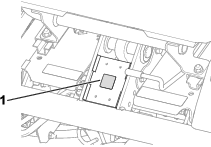
Reducing the Tire Pressure
The tires are overinflated at the factory for shipping purposes. Reduce the pressure to the proper levels before starting the machine; refer to Checking the Tire Pressure.
Burnishing the Brakes
Firmly apply the brakes and drive the machine at mowing speed until the brakes are hot, as indicated by their smell. You may need to adjust the brakes after the break-in period; refer to Adjusting the Brakes.
Product Overview
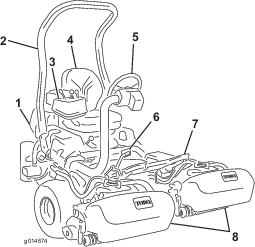
Traction Pedal
The traction pedal (Figure 11) has 3 functions: to make the machine move forward, to move it backward, and to stop the machine. Press the top of the pedal to move forward and the bottom of the pedal to move backward or to assist in stopping when moving forward. Also, allow the pedal to move to the neutral position to stop the machine. For your comfort, do not rest the heal of your foot on the reverse pad of the traction pedal when you are driving the machine forward. (Figure 12).
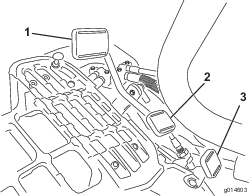

Ground speeds are as follows:
-
3.2 to 8 km/h (2 to 5 mph) forward mowing speed
-
16 km/h (10 mph) maximum transport speed
-
4.0 km/h (2.5 mph) reverse speed
Steering-Arm-Locking Pedal
Press the pedal (Figure 11) and raise or lower the steering arm for operator comfort, then, release the pedal to lock the arm in place.
Throttle Lever
The throttle lever (Figure 13) allows you to control the speed of the engine. Move the throttle lever toward the FAST position to increases the engine speed; move it toward the SLOW position to decrease the engine speed.
Note: You cannot stop the engine using the throttle lever.

Raise/Lower Mow Control
Moving the control (Figure 13) forward during cutting operation lowers the cutting units and starts the reels. Pull back on the control to stop the reels and raise the cutting units. To stop the reels without raising the cutting units, pull back on the control momentarily and releasing it. Start the reels by moving the control forward.
Functional Control Lever
The functional control lever (Figure 13) provides 2 traction selections plus a NEUTRAL position. You can shift from mow to transport or transport to mow (not to neutral) while the machine is in motion; no damage will result.
-
REAR position—neutral position; use when backlapping the reels
-
MIDDLE position—use when cutting grass
-
FRONT position—use when driving the machine between job sites
Ignition Switch
Insert the key into the switch (Figure 13) and turn it clockwise to the START position to start the engine. Release the key as soon as the engine starts; the key moves to the ON position. Turn the key counterclockwise to the STOP position to shut off the engine.
Battery Warning Light
The light (Figure 13) glows if the battery charge is low.
Engine-Oil Pressure Light
The light (Figure 13) glows if the engine-oil pressure drops below a safe level.
Water Temperature Light
The light (Figure 13) glows and the engine automatically shuts down when the engine-coolant temperature gets too high. If the engine shuts down, you can start the engine and drive the machine for 10 seconds before it will shutdown again, allowing you to move the machine to a location where you can allow it to cool down.
Service Indicator Light
The service indicator light (Figure 13) illuminates when the machine sensors detect an issue with 1 of the systems of the machine. If this light illuminates, stop what you are doing and drive to a safe location where you or a service technician can diagnose the problem. For more information on diagnosing system issues using the service indicator light, refer to Diagnosing the Service Indicator Light.
Glow-Plug Indicator Light
When the glow-plug indicator light (Figure 13) is lit, it indicates the glow plugs are on.
Note: The glow-plug indicator light may illuminate for a short time after the engine has started; this is normal.
Hour Meter
The hour meter (Figure 14) indicates the total hours the machine has operated. It starts to function whenever you rotate the ignition switch to the ON position.

Parking Brake Lever
Pull the brake lever (Figure 15) to engage the parking brake. Disengage it by squeezing the release lever on the underside of the brake lever and lowering it to the released position. Engage the parking brake whenever you leave the machine.
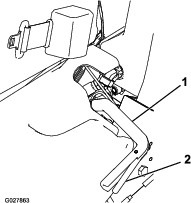
Backlap Lever
The backlap lever is located under the plastic cover to the left of the seat. Use the backlap lever (Figure 16) in conjunction with the raise/lower mow control lever and the reel-speed control for backlapping the reels.
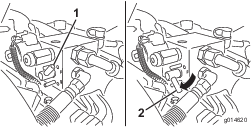
Reel-Speed Control
The reel-speed control is located under the plastic cover to the left of the seat. Use the reel-speed control (Figure 17) to adjust the speed of the reels.
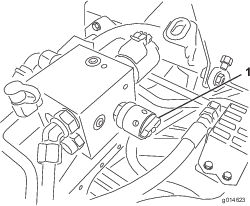
Seat-Adjusting Lever
The seat-adjusting lever is located on the front, left corner of the seat (Figure 18), allowing you to adjust the seat forward and rearward.
Note: If you need additional adjustment on the seat, you can remove the 4 nuts securing the seat slide rails to the base and move the seat slide rails to the second set of mounting holes provided.
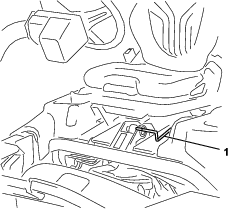
Fuel-Shutoff Valve
Close the fuel-shutoff valve (Figure 19), behind the seat and under the fuel tank, when storing or transporting the machine on a truck or trailer.
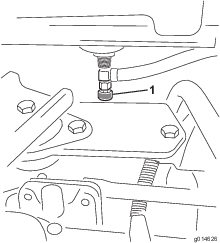
Note: Specifications and design are subject to change without notice.
| Width of cut | 151 cm (59.5 inches) |
| Wheel tread | 128 cm (50.5 inches) |
| Wheel base | 123 cm (48.5 inches) |
| Overall length (w/baskets) | 249 cm (98 inches) |
| Overall width | 179 cm (70.5 inches) |
| Overall height | 205 cm (81 inches) |
| Net Weight w/reels (11 Blade) | 696 kg (1,535 lb) |
Attachments/Accessories
A selection of Toro approved attachments and accessories is available for use with the machine to enhance and expand its capabilities. Contact your Authorized Service Dealer or Distributor or go to www.Toro.com for a list of all approved attachments and accessories.
To best protect your investment and maintain optimal performance of your Toro equipment, count on Toro genuine parts. When it comes to reliability, Toro delivers replacement parts designed to the exact engineering specification of our equipment. For peace of mind, insist on Toro genuine parts.
Operation
Note: Determine the left and right sides of the machine from the normal operating position.
Before Operation Safety
General Safety
-
Never allow children or untrained people to operate or service the machine. Local regulations may restrict the age of the operator. The owner is responsible for training all operators and mechanics.
-
Become familiar with the safe operation of the equipment, operator controls, and safety signs.
-
Know how to stop the machine and shut off the engine quickly.
-
Check that operator-presence controls, safety switches, and shields are attached and functioning properly. Do not operate the machine unless they are functioning properly.
-
Before mowing, always inspect the machine to ensure that the cutting units are in good working condition.
-
Inspect the area where you will use the machine and remove all objects that the machine could throw.
Fuel Safety
-
Use extreme care in handling fuel. It is flammable and its vapors are explosive.
-
Extinguish all cigarettes, cigars, pipes, and other sources of ignition.
-
Use only an approved fuel container.
-
Do not remove the fuel cap or fill the fuel tank while the engine is running or hot.
-
Do not add or drain fuel in an enclosed space.
-
Do not store the machine or fuel container where there is an open flame, spark, or pilot light, such as on a water heater or other appliance.
-
If you spill fuel, do not attempt to start the engine; avoid creating any source of ignition until the fuel vapors have dissipated.
Fuel Specification
-
Fuel tank capacity: 22.7 L (6 U.S. gallons)
-
Recommended Fuel:
-
For best results, use only clean, fresh diesel fuel or biodiesel fuels with low (<500 ppm) or ultra low (<15 ppm) sulfur content. The minimum cetane rating should be 40. Purchase fuel in quantities that can be used within 180 days to ensure fuel freshness.
-
Use summer-grade diesel fuel (No. 2-D) at temperatures above -7° C (20° F) and winter-grade (No. 1-D or No. 1-D/2-D blend) below that temperature. Using winter-grade fuel at lower temperatures provides lower flash point and cold flow characteristics that will ease starting and reduce fuel filter plugging.
Note: Using summer-grade fuel above -7° C (20° F) will contribute toward longer fuel pump life and increased power compared to winter-grade fuel.
-
This machine can also use a biodiesel blended fuel of up to B20 (20% biodiesel, 80% petrodiesel). The petrodiesel portion should be low or ultra-low sulfur. Observe the following precautions:
-
The biodiesel portion of the fuel must meet specification ASTM D6751 or EN14214.
-
The blended fuel composition should meet ASTM D975 or EN590.
-
Painted surfaces may be damaged by biodiesel blends.
-
Use B5 (biodiesel content of 5%) or lesser blends in cold weather.
-
Monitor seals, hoses, gaskets in contact with fuel as they may be degraded over time.
-
Fuel filter plugging may be expected for a time after converting to biodiesel blends.
-
Contact your authorized Toro distributor for more information on biodiesel.
-
-
Filling the Fuel Tank
-
Clean around the fuel-tank cap and remove it (Figure 20 or Figure 21).
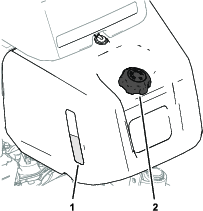
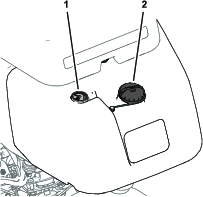
-
Add the specified fuel to the fuel tank until the level is 25 mm (1 inch) below the bottom of the filler neck.
This space in the tank allows the fuel to expand. Watch the fuel level in the sight gauge or fuel gauge when you are filling the tank.
Important: Do not fill the fuel tank completely full.
-
Install the cap.
Note: You will hear a click sound when the cap is secure.
-
Wipe up any spilled fuel.
Performing Daily Maintenance
Before starting the machine each day, perform the following procedures:
-
Check the engine-oil level—refer to Checking the Engine Oil.
-
Drain water from the fuel filter—refer to Draining Water from the Fuel Filter.
-
Check the cooling system—refer to Cooling System Maintenance.
-
Check the tire pressure—refer to Checking the Tire Pressure.
-
Check the hydraulic-fluid level—refer to Checking the Hydraulic-Fluid Level.
-
Check the reel-to-bedknife contact—refer to Checking the Reel-to-Bedknife Contact.
During Operation Safety
General Safety
-
The owner/operator can prevent and is responsible for accidents that may cause personal injury or property damage.
-
Wear appropriate clothing, including eye protection; long pants; slip-resistant, substantial foot protection; and hearing protection. Tie back long hair and do not wear jewelry.
-
Do not operate the machine while ill, tired, or under the influence of alcohol or drugs.
-
Never carry passengers on the machine and keep bystanders and pets away from the machine during operation.
-
Operate the machine only in good visibility to avoid holes or hidden hazards.
-
Avoid mowing on wet grass. Reduced traction could cause the machine to slide.
-
Before you start the engine, ensure that all drives are in neutral, the parking brake is engaged, and you are in the operating position.
-
Keep your hands and feet away from the cutting units. Keep clear of the discharge opening at all times.
-
Look behind and down before backing up to be sure of a clear path.
-
Use care when approaching blind corners, shrubs, trees, or other objects that may obscure your vision.
-
Do not mow near drop-offs, ditches, or embankments. The machine could suddenly roll over if a wheel goes over the edge or if the edge gives way.
-
Stop the cutting units whenever you are not mowing.
-
Stop the machine and inspect the cutting units after striking an object or if there is an abnormal vibration in the machine. Make all necessary repairs before resuming operation.
-
Slow down and use caution when making turns and crossing roads and sidewalks with the machine. Always yield the right-of-way.
-
Disengage the drive to the cutting unit and shut off the engine before adjusting the height of cut (unless you can adjust it from the operating position).
-
Never run an engine in an area where exhaust gasses are enclosed.
-
Never leave a running machine unattended.
-
Before leaving the operating position (including to empty the catchers or to unclog the chute), do the following:
-
Park the machine on level ground.
-
Disengage the power take-off and lower the attachments.
-
Engage the parking brake.
-
Shut off the engine and remove the key.
-
Wait for all moving parts to stop.
-
-
Do not operate the machine when there is the risk of lightning.
-
Do not use the machine as a towing vehicle.
-
Use accessories, attachments, and replacement parts approved by The Toro® Company only.
Rollover Protection System (ROPS) Safety
-
Do not remove the ROPS from the machine.
-
Ensure that the seat belt is attached and that you can release it quickly in an emergency.
-
Always wear your seat belt if your machine has a fixed roll bar.
-
Check carefully for overhead obstructions and do not contact them.
-
Keep the ROPS in safe operating condition by thoroughly inspecting it periodically for damage and keeping all the mounting fasteners tight.
-
Replace a damaged ROPS. Do not repair or alter it.
Slope Safety
-
Slopes are a major factor related to loss of control and rollover accidents, which can result in severe injury or death. You are responsible for safe slope operation. Operating the machine on any slope requires extra caution.
-
Evaluate the site conditions to determine if the slope is safe for machine operation, including surveying the site. Always use common sense and good judgment when performing this survey.
-
Review the slope instructions, listed below, for operating the machine on slopes. Before you operate the machine, review the site conditions to determine whether you can operate the machine in the conditions on that day and at that site. Changes in the terrain can result in a change in slope operation for the machine.
-
Avoid starting, stopping, or turning the machine on slopes. Avoid making sudden changes in speed or direction. Make turns slowly and gradually
-
Do not operate a machine under any conditions where traction, steering, or stability is in question.
-
Remove or mark obstructions such as ditches, holes, ruts, bumps, rocks, or other hidden hazards. Tall grass can hide obstructions. Uneven terrain could overturn the machine.
-
Be aware that operating the machine on wet grass, across slopes, or downhill may cause the machine to lose traction. Loss of traction to the drive wheels may result in sliding and a loss of braking and steering.
-
Use extreme caution when operating the machine near drop-offs, ditches, embankments, water hazards, or other hazards. The machine could suddenly roll over if a wheel goes over the edge or the edge caves in. Establish a safety area between the machine and any hazard.
-
Identify hazards at the base of the slope. If there are hazards, mow the slope with a pedestrian-controlled machine.
-
If possible, keep the cutting units lowered to the ground while operating on slopes. Raising the cutting units while operating on slopes can cause the machine to become unstable.
-
Use extreme caution with grass-collection systems or other attachments. These can change the stability of the machine and cause a loss of control.
-
Breaking in the Machine
Refer to the engine Owner’s Manual supplied with the machine for oil change and maintenance procedures recommended during the break-in period.
Only 8 hours of operation is required for the break-in period.
Since the first hours of operation are critical to future dependability of the machine, monitor its functions and performance closely so that minor difficulties, which could lead to major problems, are noted and can be corrected. Inspect the machine frequently during break-in for signs of oil leakage, loose fasteners, or any other malfunction.
Starting the Engine
Important: Do not use ether or other types of starting fluid.
Note: You may need to bleed the fuel system before starting the engine if any of the following situations have occurred:
-
Initial start up of a new engine
-
The engine has ceased running due to lack of fuel.
-
Maintenance has been performed upon fuel system components; ie. filter replaced, etc.
Refer to your engine owner’s manual.
-
Sit on the seat, lock the parking brake, disengage the raise/lower mow control and move the functional-control lever to the NEUTRAL position.
-
Remove your foot from the traction pedal and make sure the pedal is in the NEUTRAL position.
-
Move the throttle lever to the SLOW position.
-
Insert the key into the switch and rotate it to the ON position. Hold it in the ON position until the glow-plug-indicator light goes off (approximately 6 seconds).
-
Turn the ignition key to the START position.
Important: To prevent overheating of the starter motor, do not engage the starter longer than 10 seconds. After 10 seconds of continuous cranking, wait 60 seconds before engaging the starter motor again.
-
Release the key when the engine starts and allow it to move to the ON position.
-
Allow the engine to warm up for a few minutes before operating.
Important: When starting the engine for the first time or after an overhaul of the engine, operate the machine in forward and reverse for 1 to 2 minutes. Turn the steering wheel to the left and right to check the steering response. Then shut the engine off and wait for all moving parts to stop; refer to Shutting Off the Engine. Check for oil leaks, loose parts and any other noticeable malfunctions.
Checking the Machine after Starting the Engine
-
Move the throttle lever to the FAST position.
-
Move the raise/lower mow control lever forward momentarily.
The cutting units should lower and all the reels should rotate.
Note: The function lever should be in the middle (mow) position for the reels run when lowering the cutting units
-
Move the raise/lower mow control lever rearward.
The cutting reels should stop rotating and the cutting units should raise to the full transport position.
-
Engage the brake to keep the machine from moving, and operate the traction pedal through the forward and reverse positions.
-
Continue the above procedure for 1 or 2 minutes. Move the functional-control lever to the NEUTRAL position, engage the parking brake, and shut off the engine.
-
Check for fluid leaks and tighten the hydraulic fittings if any leaks are found.
Note: When the machine is new and the bearings and reels are tight, it is necessary to use the FAST throttle-lever position for this check. A fast throttle setting may not be required after the break-in period.
Note: If fluid leaks continue to appear, contact your authorized Toro distributor for assistance and, if necessary, replacement parts.
Important: A trace of fluid on the motor or wheel seals is normal. Seals require a small amount of lubrication to perform properly.
Shutting Off the Engine
-
Move the throttle lever to the SLOW position, pull back the raise/lower mow control, and move the functional-control lever to the NEUTRAL position.
-
Rotate the ignition key to the OFF position to shut off the engine. Remove the key from the switch to prevent accidental starting.
-
Close the fuel shut-off valve before storing the machine.
Checking the Safety-Interlock System
Caution
If the safety interlock switches are disconnected or damaged the machine could operate unexpectedly, causing personal injury.
-
Do not tamper with the interlock switches.
-
Check the operation of the interlock switches daily and replace any damaged switches before operating the machine.
The purpose of the safety-interlock system is to prevent operation of the machine where there is possible injury to you or damage to the machine.
The safety-interlock system prevents the engine from starting unless:
-
The traction pedal is in the NEUTRAL position.
-
The functional-control lever is in the NEUTRAL position.
The safety-interlock system prevents the machine from moving unless:
-
The parking brake is disengaged.
-
You are seated in the operator's seat.
-
The functional-control lever is in the MOW position or the TRANSPORT position.
The safety-interlock system prevents the reels from operating unless the functional-control lever is in the MOW position.
Checking the Traction Pedal
| Maintenance Service Interval | Maintenance Procedure |
|---|---|
| Before each use or daily |
|
Perform the following system checks daily to ensure that the interlock system is operating correctly:
-
Sit on the seat, move the traction pedal to the NEUTRAL position, move the functional-control lever to the NEUTRAL position, and engage the parking brake.
-
Try to move the traction pedal forward or backward.
The pedal should not move, which indicates that the interlock system is operating correctly. Correct the problem if it is not operating properly.
Checking the Function Control
-
Sit on the seat, move the traction pedal to the NEUTRAL position, move the functional-control lever to the NEUTRAL position, and engage the parking brake.
-
Move the functional-control lever to the MOW position or the TRANSPORT position and try to start the engine.
The engine should not turnover or start, which indicates that the interlock system is operating correctly. Correct the problem if it is not operating properly.
-
Sit on the seat, move the traction pedal to the NEUTRAL position, move the functional-control lever to the NEUTRAL position, and engage the parking brake.
-
Start the engine and move the functional-control lever to the MOW position or the TRANSPORT position.
The engine should shut off, which indicates that the interlock system is operating correctly.
Correct the problem if it is not operating properly.
Checking the Operator’s Presence Switch
-
Sit on the seat, move the traction pedal to the NEUTRAL position, move the functional control lever to the NEUTRAL position, and engage the parking brake.
-
Start the engine.
-
Release the parking brake, move the functional control lever to the MOW position, and rise from the seat.
The engine should shut off, which indicates that the interlock system is operating correctly. Correct the problem if it is not operating properly.
Checking the Raise/Lower Mow Control
-
Sit on the seat, move the traction pedal to the NEUTRAL position, move the functional control lever to the NEUTRAL position, and engage the parking brake.
-
Start the engine.
-
Move the raise/lower mow control forward to lower the cutting units. The cutting units should lower but not start rotating.
If they start rotating, the interlock system is not operating correctly; correct the problem before operating the machine.
Driving the Machine without Mowing
-
Ensure that the cutting units are fully raised.
-
Move the functional-control lever to the TRANSPORT position.
-
Use the brakes to slow the machine while going down steep hills to avoid loss of control.
-
Always approach rough areas at a reduced speed and cross severe undulations carefully.
-
Familiarize yourself with the width of the machine. Do not attempt to pass between objects that are close together to prevent costly damage and downtime.
Mowing the Green
Important: If the leak detector alarm (if equipped on your model) sounds or you notice an oil leak while cutting on a green, immediately raise the cutting units, drive directly off the green, and stop the machine in an area away from the green. Determine the cause of the leak and correct the problem.
Before mowing greens, find a clear area and practice performing basic machine functions (e.g., starting and stopping the machine, raising and lowering the cutting units, and turning).
Inspect the green for debris, remove the flag from the cup, and determine the best direction to mow. Base the direction to mow on the previous mowing direction. Always mow in an alternate pattern from the previous mowing so that the grass blades are less apt to lay down and therefore be difficult to trap between the reel blades and the bedknife.
Cutting the Green
-
Approach the green with the functional-control lever in the MOW position and the throttle at full speed.
-
Start on 1 edge of the green so that you can use the ribbon procedure of cutting.
Note: This holds compaction to a minimum and leaves a neat, attractive pattern on the greens.
-
Push forward the raise/lower mow lever as the front edges of the grass baskets cross the outer edge of the green.
Note: This procedure drops the cutting units to the turf and starts the reels.
Important: The center cutting unit drops and raises slightly after the front cutting units do; therefore, you should practice gaining the required timing necessary to minimize the cleanup mowing operation.
Note: The delay in raising and lowering the center cutting unit depends on hydraulic fluid temperature. Cold hydraulic fluid results in a longer delay. As the fluid temperature increases, the delay time becomes shorter.
-
Overlap a minimal amount with the previous cut on return passes.
Note: To assist in maintaining a straight line across the green and keeping the machine an equal distance from the edge of the previous cut, establish an imaginary sight line approximately 1.8 to 3 m (6 to 10 ft) ahead of the machine to the edge of the uncut portion of the green (Figure 23). Some operators find it useful to include the outer edge of the steering wheel as part of the sight line; i.e., keep the steering wheel edge aligned with a point that is always kept the same distance away from the front of the machine.
-
As the front edges of the baskets cross the edge of the green, pull back the raise/lower mow lever rearward and hold it until all the cutting units have risen. This stops the reels and lifts the cutting units.
Note: It is important to time this step correctly so that you do not cut into the fringe area, yet cut as much of the green as possible to minimize the amount of grass left to mow around the outer periphery.
-
To cut down on operating time and to ease the lineup for the next pass, momentarily turn the machine in the opposite direction, then turn it in the direction of the uncut portion. This movement is a tear-shaped turn (Figure 22), which quickly lines the machine up for your next pass.
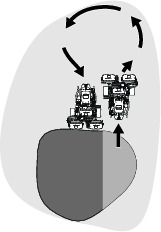
Note: Try to make as short of a turn as possible, except during warmer weather—a wider arc minimizes the turf bruising.
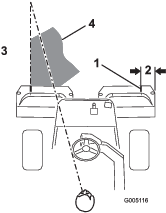
Note: The steering wheel does not return to its original position after you complete a turn.
Important: Never stop the machine on a green while the cutting units are engaged, as damage to the turf may result. Stopping the machine on a wet green may leave marks or indentations from the wheels.
Cutting the Periphery and Finishing Job
-
Finish cutting the green by mowing the outer periphery. Change the direction of cutting from the previous mowing.
Note: Always keep weather and turf conditions in mind and be sure to change the direction of mowing from the previous cutting.
-
When finished mowing the outer periphery, tap the raise/lower mow lever rearward to stop the reels, then drive off the green. When all the cutting units are off the green, raise the cutting units.
Note: This minimizes grass clumps left on the green.
-
Replace the flag.
-
Empty the grass baskets of all clippings before transporting to the next green.
Note: Heavy wet clippings place an undue strain on the baskets and add unnecessary weight to the machine, thereby increasing the load on the engine, hydraulic system, brakes, etc.
After Operation Safety
General Safety
-
Clean grass and debris from the cutting units, drives, mufflers, cooling screens, and engine to help prevent fires. Clean up oil or fuel spills.
-
Shut off the fuel while storing or transporting the machine.
-
Allow the engine to cool before storing the machine in any enclosure.
-
Never store the machine or fuel container where there is an open flame, spark, or pilot light, such as on a water heater or on other appliances.
Inspecting and Cleaning after Mowing
| Maintenance Service Interval | Maintenance Procedure |
|---|---|
| Before each use or daily |
|
After mowing, thoroughly wash the machine with a garden hose without a nozzle so that excessive water pressure does not contaminate and damage the seals and bearings. Do not wash a warm engine or the electrical connections with water.
After cleaning the machine, perform the following:
-
Inspect the machine for possible hydraulic fluid leaks, damage or wear to hydraulic and mechanical components.
-
Inspect the cutting units for sharpness.
-
Lubricate the brake-shaft assembly with SAE 30 oil or spray lubricant to deter corrosion and help keep the machine performing satisfactorily during the next mowing operation.
Hauling the Machine
-
Use care when loading or unloading the machine into a trailer or a truck.
-
Use a full-width ramp for loading the machine into a trailer or a truck.
-
Tie the machine down securely using straps, chains, cable, or ropes. Both front and rear straps should be directed down and outward from the machine.
Towing the Machine
In case of an emergency, you can tow the machine for up to 0.4 km (1/4 mile).
Important: Do not tow the machine faster than 3 to 5 km/h (2 to 3 mph) to avoid damaging the drive system. If you must move the machine more than 0.4 km (1/4 mile), transport it on a truck or trailer.
Maintenance
Warning
Failure to properly maintain the machine could result in premature failure of machine systems causing possible harm to you or bystanders.
Keep the machine well maintained and in good working order as indicated in these instructions.
Note: Determine the left and right sides of the machine from the normal operating position.
Note: Download a free copy of the electrical or hydraulic schematic by visiting www.Toro.com and searching for your machine from the Manuals link on the home page.
Important: Refer to your engine Operator’s Manual for additional maintenance procedures.
Caution
If you leave the key in the ignition switch, someone could accidently start the engine and seriously injure you or other bystanders.
Remove the key from the ignition and disconnect the wires from the spark plugs before you do any maintenance. Set the wires aside so that they do not accidentally contact the spark plugs.
Recommended Maintenance Schedule(s)
| Maintenance Service Interval | Maintenance Procedure |
|---|---|
| After the first hour |
|
| After the first 8 hours |
|
| After the first 10 hours |
|
| After the first 50 hours |
|
| Before each use or daily |
|
| Every 50 hours |
|
| Every 150 hours |
|
| Every 200 hours |
|
| Every 800 hours |
|
| Every 2 years |
|
Pre-Maintenance Procedures
Pre-Maintenance Safety
-
Before adjusting, cleaning, repairing, or leaving the machine, do the following:
-
Park the machine on a level surface.
-
Move the throttle switch to the low-idle position.
-
Disengage the cutting units.
-
Lower the cutting units.
-
Ensure that the traction is in neutral.
-
Engage the parking brake.
-
Shut off the engine and remove the key.
-
Wait for all moving parts to stop.
-
Allow machine components to cool before performing maintenance.
-
-
If the cutting units are in the transport position, use the positive mechanical lock (if available) before you leave the machine unattended.
-
If possible, do not perform maintenance while the engine is running. Keep away from moving parts.
-
Use jack stands to support the machine or components when required.
-
Carefully release pressure from components with stored energy.
Engine Maintenance
Engine Safety
-
Shut off the engine before checking the oil or adding oil to the crankcase.
-
Do not change the governor speed or overspeed the engine.
Servicing the Air Cleaner
| Maintenance Service Interval | Maintenance Procedure |
|---|---|
| Every 200 hours |
|
-
Check the air-cleaner body for damage which could cause an air leak; replace it if it is damaged. Check the whole intake system for leaks, damage, or loose hose clamps.
-
Changing the air filter before it is necessary increases the chance of dirt entering the engine when the filter is removed.
-
Ensure that the cover is seated correctly and seals with the air cleaner body.
-
Release the latches securing the air-cleaner cover to the air-cleaner body (Figure 25).
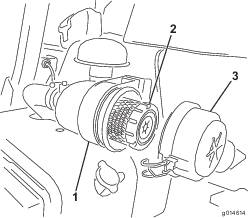
-
Remove the cover from the air-cleaner body.
-
Before removing the filter, use low pressure air (275 kPa (40 psi), clean and dry) to help remove large accumulations of debris packed between the outside of the primary filter and the canister. This cleaning process prevents debris getting into the intake when you remove the primary filter.
Important: Avoid using high-pressure air that could force dirt through the filter into the intake tract.
-
Remove and replace the primary filter, as follows:
Important: Do not clean the used element.
-
Inspect the new filter for shipping damage; do not use a damaged element.
-
Carefully pull the old filter out of the filter body and discard it.
-
Insert the new filter by applying pressure to the outer rim of the element to seat it in the canister, checking the sealing end of the filter and the body.
Important: Do not apply pressure to the flexible center of the filter.
-
-
Clean the dirt ejection port located in the removable cover. Remove the rubber outlet valve from the cover, clean the cavity and replace the outlet valve.
-
Install the cover orienting the rubber outlet valve in a downward position—between approximately 5 o’clock to 7 o’clock when viewed from the end.
-
Secure the latches (Figure 25).
Servicing the Engine Oil
Checking the Engine Oil
| Maintenance Service Interval | Maintenance Procedure |
|---|---|
| Before each use or daily |
|
The engine is shipped with 3.7 L (3.9 US qt) (with filter) of oil in the crankcase; however, you must check the oil level before and after starting the engine the first time.
Use high-quality engine oil that meets the following specifications:
-
API Classification Level Required: CH–4, CI–4 or higher.
-
Preferred oil: SAE 10W–30
-
Alternate oil: SAE 15W–40
Toro Premium Engine oil is available from your distributor in the 10W–30 viscosity. See the Parts Catalog for part numbers.
Note: The best time to check the engine oil is when the engine is cool before it has been started for the day. If it has already been run, allow the oil to drain back down to the sump for at least 10 minutes before checking. If the oil level is at or below the Add mark on the dipstick, add oil to bring the oil level to the FULL mark. Do not overfill.
Important: Keep the engine oil level between the upper and lower limits on the oil gauge; the engine may fail if you run it with too much or too little oil.
-
Position the machine on a level surface.
-
Remove the dipstick and wipe it with a clean rag (Figure 27).
Important: Remove the dipstick while filling the engine with oil. When adding engine oil or filling oil, there must be clearance between the oil fill device and the oil fill hole in the valve cover as shown in Figure 26. This clearance is necessary to permit venting when filling, which prevents the oil from overrunning into the breather.
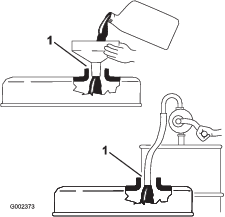
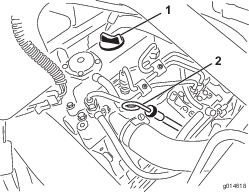
-
Push the dipstick into the tube and make sure it is seated fully.
-
Remove the dipstick from the tube and check the oil level
Note: If the oil level is low, remove the filler cap from the valve cover and slowly add enough oil to raise the level to the FULL mark on the dipstick. Add the oil slowly and check the level often during this process. Do not overfill.
-
Replace the dipstick.
-
Start and run the engine at idle for 30 seconds, then shut the engine off. Wait 30 seconds, then repeat steps 2 through 5.
-
Install the filler cap and dipstick firmly in place.
Changing the Engine Oil and Filter
| Maintenance Service Interval | Maintenance Procedure |
|---|---|
| After the first 50 hours |
|
| Every 150 hours |
|
-
Remove the drain plug and let oil flow into a drain pan. When the oil stops, install the drain plug (Figure 28).
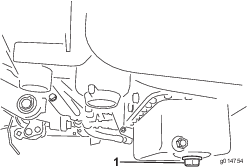
-
Remove the oil filter (Figure 29). Apply a light coat of clean oil to the new filter gasket.
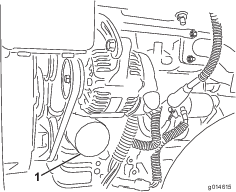
-
Screw the filter on by hand until the gasket contacts the filter adapter, then tighten 1/2 to 3/4 turn further. Do not overtighten.
-
Add oil to the crankcase; refer to Checking the Engine Oil.
-
Dispose of the used oil properly.
Fuel System Maintenance
Draining Water from the Fuel Filter
| Maintenance Service Interval | Maintenance Procedure |
|---|---|
| Before each use or daily |
|
-
Park the machine on a level surface and shut off the engine.
-
Place a drain pan under the fuel filter.
-
Open the drain plug on the fuel filter approximately one turn and drain any accumulated water (Figure 30).
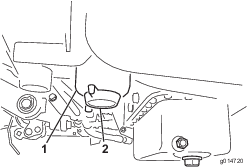
-
Tighten the plug after draining.
Note: Because the accumulated water will be mixed with diesel fuel, drain the fuel filter into a suitable container and dispose of it properly.
Replacing the Fuel Filter/Water Separator
| Maintenance Service Interval | Maintenance Procedure |
|---|---|
| Every 800 hours |
|
-
Close the fuel-shutoff valve (Figure 31) below the fuel tank.

-
Clean the area where the filter canister mounts (Figure 32).
-
Place a drain pan under the fuel filter.
-
Open the filter drain plug (Figure 32).

-
Unscrew the filter canister and dispose of it according to local regulations.
-
Screw the filter on by hand until the gasket contacts the filter adapter, then tighten 1/2 to 3/4 turn further.
-
Ensure that the filter-drain plug is closed. Open the fuel-shutoff valve.
Inspecting the Fuel Lines and Connections
| Maintenance Service Interval | Maintenance Procedure |
|---|---|
| Every 2 years |
|
Inspect the fuel lines for deterioration, damage, or loose connections.
Electrical System Maintenance
Electrical System Safety
-
Disconnect the battery before repairing the machine. Disconnect the negative terminal first and the positive last. Connect the positive terminal first and the negative last.
-
Charge the battery in an open, well-ventilated area, away from sparks and flames. Unplug the charger before connecting or disconnecting the battery. Wear protective clothing and use insulated tools.
Warning
Battery posts, terminals, and related accessories contain lead and lead compounds, chemicals known to the State of California to cause cancer and reproductive harm. Wash hands after handling.
Servicing the Battery
| Maintenance Service Interval | Maintenance Procedure |
|---|---|
| Every 50 hours |
|
Properly maintain the battery electrolyte and keep the top of the battery clean. Store the machine in a cool place to prevent the battery from running down.
The battery cables must be tight on the terminals to provide good electrical contact.
Danger
Battery electrolyte contains sulfuric acid, which can be fatal if consumed and causes severe burns.
-
Do not drink electrolyte and avoid contact with skin, eyes or clothing. Wear safety glasses to shield your eyes and rubber gloves to protect your hands.
-
Fill the battery where clean water is always available for flushing the skin.
-
Check the electrolyte level in the in the cells of the battery.
-
If needed, add distilled or demineralized water into the cell of the battery.
Note: Raise the electrolyte level only to the bottom of the split ring inside each cell.
-
Clean the top of the battery by washing it periodically with a brush dipped in ammonia or bicarbonate of soda solution.
-
Flush the top surface of the battery with water after cleaning it.
Important: Do not remove the fill caps while cleaning the battery.
Warning
Incorrect battery cable routing could damage the tractor and cables, causing sparks. Sparks can cause the battery gasses to explode, resulting in personal injury.
-
Always disconnect the negative (black) battery cable before disconnecting the positive (red) cable.
-
Always connect the positive (red) battery cable before connecting the negative (black) cable.
If corrosion occurs at the terminals, disconnect the cables, negative (-) cable first, and scrape the clamps and terminals separately. Connect the cables, positive (+) cable first, and coat the terminals with petroleum jelly.
Locating the Fuses
The fuses in the electrical system are located under the seat (Figure 33).
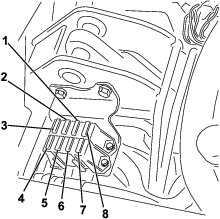
Drive System Maintenance
Checking the Tire Pressure
| Maintenance Service Interval | Maintenance Procedure |
|---|---|
| Before each use or daily |
|
Vary the tire pressure for all 3 wheels, depending upon your turf conditions, from a minimum of 83 to a maximum of 110 kPa (12 psi to 16 psi).
Checking the Torque of the Wheel Nuts
| Maintenance Service Interval | Maintenance Procedure |
|---|---|
| After the first hour |
|
| After the first 10 hours |
|
| Every 200 hours |
|
Warning
Failure to maintain proper torque of the wheel nuts could result in personal injury.
Torque the wheel nuts to the specified torque at the specified intervals.
Wheel nut torque specification: 95 to 122 N∙m (70 to 90 ft-lb)
Note: To ensure even distribution, torque the wheel nuts in a X pattern.
Adjusting the Transmission for Neutral
If the machine creeps when the traction-control pedal is in the NEUTRAL position, adjust the neutral-return mechanism.
-
Ensure that the bypass valve is closed.
-
Lift the machine and support it at the frame so that 1 of the front wheels is off the floor.
Note: If machine is equipped with a 3-Wheel Drive Kit, also raise and block rear wheel.
-
Start the engine, move the throttle to the SLOW position, and ensure that the front wheel that is off the floor is not rotating.
-
If the wheel is rotating, shut off the engine and proceed as follows:
-
Loosen the nut securing the eccentric to the top of the hydrostat (Figure 34).
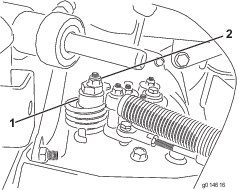
-
Move the functional-control lever to the NEUTRAL position and the throttle to the SLOW position. Start the engine.
-
Rotate the eccentric until creep does not occur in either direction. When the wheel stops rotating, tighten the nut locking the eccentric and the adjustment (Figure 34). Verify the adjustment with the throttle in the SLOW and FAST position.
Note: If the wheel still turns when the eccentric is at the maximum adjustment, contact your authorized Toro distributor or refer to the Service Manual for further adjustment.
-
Adjusting the Transport Speed
Obtaining the Maximum Transport Speed
The traction pedal comes adjusted for maximum-transport speed, but you may need to adjust it if the pedal reaches full stroke before it contacts the pedal stop, or if you want to a decrease the transport speed.
To obtain the maximum-transport speed, put the functional control lever in the TRANSPORT position and press down on the traction pedal. If the pedal contacts the stop (Figure 35) before you feel tension on the cable, perform the following adjustment procedure:
-
Put the functional-control lever in the TRANSPORT position and loosen the locknut securing the pedal stop to the floor plate (Figure 35).
-
Tighten the pedal stop until it does not contact the traction pedal.
-
Continue applying a light load on the transport pedal and adjust the pedal stop so it contacts the pedal rod and tighten the nuts.
Important: Ensure that the tension on the cable is not excessive or you will reduce the cable life.
Reducing the Transport Speed
-
Press down on the traction pedal and loosen the locknut securing the pedal stop to the floor plate.
-
Loosen the pedal stop until you obtain the desired transport speed.
-
Tighten the locknut securing the pedal stop.
Adjusting the Mowing Speed
The mow speed is set to 3.8 mph at the factory.
You can adjust the forward moving speed from 0 to 8 km/h (0 to 5 mph).
-
Loosen the jam nut on the trunnion bolt (Figure 36).
-
Loosen the nut securing the lock and mow brackets on the pedal pivot.
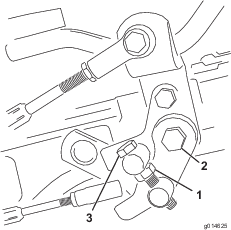
-
Rotate the trunnion bolt clockwise to reduce the mowing speed and counterclockwise to increase the mowing speed.
-
Tighten the jam nut on the trunnion bolt and the nut on the pedal pivot to lock the adjustment (Figure 36). Check the adjustment and adjust as required.
Cooling System Maintenance
Cooling System Safety
-
Swallowing engine coolant can cause poisoning; keep out of reach from children and pets.
-
Discharge of hot, pressurized coolant or touching a hot radiator and surrounding parts can cause severe burns.
-
Always allow the engine to cool at least 15 minutes before removing the radiator cap.
-
Use a rag when opening the radiator cap, and open the cap slowly to allow steam to escape.
-
Cleaning the Radiator Screen
| Maintenance Service Interval | Maintenance Procedure |
|---|---|
| Before each use or daily |
|
To prevent the system from overheating, keep the radiator screen and radiator clean. Check and clean the screen and radiator daily or, if necessary, hourly. Clean these components more frequently in dusty, dirty conditions.
-
Remove the radiator screen (Figure 37).
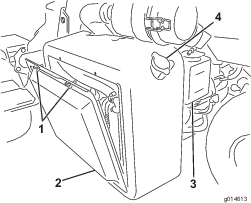
-
Working from the fan side of the radiator, blow out the radiator with compressed air.
-
Clean the screen and install it.
Checking the Engine-Coolant Level
| Maintenance Service Interval | Maintenance Procedure |
|---|---|
| Before each use or daily |
|
The capacity of the cooling system is approximately 4.6 L (4.9 US qt).
Fill the cooling system with a 50/50 solution of water and permanent ethylene glycol antifreeze. Check the level of the coolant at the beginning of each day before starting the engine.
Caution
If the engine has been running, the pressurized, hot coolant can escape and cause burns.
-
Do not open the radiator cap when the engine is running.
-
Use a rag when opening the radiator cap, and open the cap slowly to allow steam to escape.
-
Park the machine on a level surface.
-
Check the coolant level (Figure 37 and Figure 38).
It should be between the lines on the reserve tank when the engine is cold.
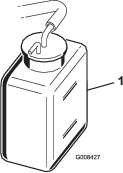
-
If the coolant is low, remove the reserve tank cap and add a 50/50 mixture of water and permanent ethylene glycol antifreeze. Do not overfill.
-
Install the reserve-tank cap.
Brake Maintenance
Adjusting the Brakes
If the brake fails to hold the machine while parked, you can adjust the brakes using the bulkhead fitting near the brake drum; contact your Authorized Service Dealer or refer to the Service Manual for more information.
Note: Burnish the brakes annually; refer to Burnishing the Brakes.
Belt Maintenance
Adjusting the Alternator Belt
| Maintenance Service Interval | Maintenance Procedure |
|---|---|
| After the first 8 hours |
|
Ensure that the belt is properly tensioned to ensure proper operation of the machine and prevent unnecessary wear.
-
Shut off the engine, set the parking brake, and remove the ignition key.
-
Apply moderate thumb pressure to the belt between the pulleys (10 kg or 22 lb). The belt should deflect 7 to 9 mm (0.28 to 0.35 inch). If not, complete the following procedure to adjust the belt tension:
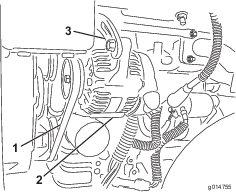
-
Loosen the bolts securing the alternator to the engine and adjusting strap.
-
Inspect the belt for wear or damage and replace if it is worn.
-
Using a lever placed between the alternator and the engine block, pull the alternator out to obtain the correct belt tension and tighten the bolts.
-
Hydraulic System Maintenance
Hydraulic System Safety
-
Seek immediate medical attention if fluid is injected into skin. Injected fluid must be surgically removed within a few hours by a doctor.
-
Ensure that all hydraulic-fluid hoses and lines are in good condition and all hydraulic connections and fittings are tight before applying pressure to the hydraulic system.
-
Keep your body and hands away from pinhole leaks or nozzles that eject high-pressure hydraulic fluid.
-
Use cardboard or paper to find hydraulic leaks.
-
Safely relieve all pressure in the hydraulic system before performing any work on the hydraulic system.
Servicing the Hydraulic Fluid
Important: Regardless of the hydraulic fluid type used, any machine used for mowing fairways, verticutting, or used during ambient temperatures above 29°C (85°F) should have the Oil Cooler Kit (Part No. 117-9314) installed.
Hydraulic Fluid Specifications
The recommended replacement fluid is as follows:
| Toro Premium All Season Hydraulic Fluid (Available in 5-gallon pails or 55-gallon drums. See the Parts Catalog or your authorized Toro distributor for part numbers.) |
Alternate fluids: If the Toro fluid is not available, other fluids may be used provided they meet all the following material properties and industry specifications. The use of synthetic fluid is not recommended. Consult with your lubricant distributor to identify a satisfactory product.
Note: Toro will not assume responsibility for damage caused by improper substitutions, so use only products from reputable manufacturers who will stand behind their recommendation.
| High Viscosity Index/Low Pour Point Anti-wear Hydraulic Fluid, ISO VG 46 | |
| Material Properties: | |
| Viscosity, ASTM D445 | cSt @ 40°C 44 to 50cSt @ 100°C 7.9 to 8.5 |
| Viscosity Index ASTM D2270 | 140 to 160 |
| Pour Point, ASTM D97 | -34°F to -49°F |
| Industry Specifications: | |
| Vickers I-286-S (Quality Level), Vickers M-2950-S (Quality Level), Denison HF-0 | |
Important: The ISO VG 46 Multigrade fluid has been found to offer optimal performance in a wide range of temperature conditions. For operation in consistently high ambient temperatures, 18°C (65°F) to 49°C (120°F), ISO VG 68 hydraulic fluid may offer improved performance.
Premium Biodegradable Hydraulic Fluid-Mobil EAL EnviroSyn 46H
Important: Mobil EAL EnviroSyn 46H is the only synthetic biodegradable fluid approved by Toro. This fluid is compatible with the elastomers used in Toro hydraulic systems and is suitable for a wide-range of temperature conditions. This fluid is compatible with conventional mineral fluids, but for maximum biodegradability and performance, the hydraulic system should be thoroughly flushed of conventional fluid. The fluid is available in 19 L (5 US gallons) containers or 208 L (55 US gallons) drums from your Mobil distributor.
Important: Many hydraulic fluids are almost colorless, making it difficult to spot leaks. A red dye additive for the hydraulic fluid is available in 20 ml (0.67 fl oz) bottles. One bottle is sufficient for 15 to 22 L (4 to 6 US gallons) of hydraulic fluid. Order Part No. 44-2500 from your authorized Toro distributor. This red dye is not recommended for use with biodegradable fluids.
Checking the Hydraulic-Fluid Level
| Maintenance Service Interval | Maintenance Procedure |
|---|---|
| Before each use or daily |
|
The hydraulic-fluid reservoir is filled at the factory with high quality hydraulic fluid. Before operating the machine each day, check the level of the hydraulic fluid. Your machine has a dipstick or a white plastic window on the front of the hydraulic-fluid reservoir (behind the seat on the left side of the machine) that is used to check the hydraulic-fluid level. The fluid should be between the window lines or the dipstick marks; if not, add more appropriate fluid.
Refer to Figure 40 for this procedure.
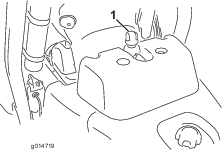
-
Position the machine on a level surface.
Note: Ensure that the machine has cooled down so that the fluid is cold.
-
Check the fluid level according to the tank on your machine:
-
If your tank has a sight window, check the oil level there and proceed to step 5.
-
If your tank does not have a sight window, locate the dipstick on the top of the hydraulic tank and proceed to step 3.
-
-
Remove the dipstick and wipe it with a clean rag, then screw the dipstick back into the tank.
-
Remove the dipstick and check the fluid level. If the fluid is between the marks on the dipstick, the level is sufficient. If the level is not between the marks, more fluid is needed.
-
Remove the cap or dipstick (depending on your machine) from the hydraulic fluid tank and slowly fill the tank with the appropriate high-quality hydraulic fluid until the level is between the 2 lines on the sight window or 2 marks on the dipstick.
-
Install the cap or dipstick and wipe up any fluid that may have spilled.
Important: Check the level of the hydraulic fluid before the engine is first started and daily thereafter.
Changing the Hydraulic Fluid and Filter
| Maintenance Service Interval | Maintenance Procedure |
|---|---|
| After the first 50 hours |
|
| Every 800 hours |
|
Hydraulic Fluid Capacity: 25.7 L (6.8 US gallons)
If the fluid becomes contaminated, have your authorized Toro distributor flush the system. Contaminated fluid looks milky or black when compared to clean fluid.
-
Clean the area around the filter mounting area (Figure 41). Place a drain pan under the filter and remove the filter.
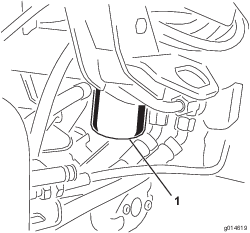
Note: If you will not be draining the fluid, disconnect and plug the hydraulic line going to the filter.
-
Fill the replacement filter with the appropriate hydraulic fluid, lubricate the sealing gasket, and hand turn it until the gasket contacts the filter head. Then tighten it 3/4 turn further.
-
Fill the hydraulic reservoir with hydraulic fluid; refer to Hydraulic Fluid Specifications and Checking the Hydraulic-Fluid Level.
-
Start the machine and run it at idle for 3 to 5 minutes to circulate the fluid and remove any air trapped in the system. Shut off the engine and check the fluid level.
-
Dispose of the fluid and filter properly.
Checking the Hydraulic Lines and Hoses
| Maintenance Service Interval | Maintenance Procedure |
|---|---|
| Before each use or daily |
|
Warning
Hydraulic fluid escaping under pressure can penetrate skin and cause injury.
-
Get immediate medical help if fluid is injected into skin.
-
Ensure that all hydraulic fluid hoses and lines are in good condition and all hydraulic connections and fittings are tight before applying pressure to the hydraulic system.
-
Keep your body and hands away from pinhole leaks or nozzles that eject high-pressure hydraulic fluid.
-
Use cardboard or paper to find hydraulic leaks.
-
Safely relieve all pressure in the hydraulic system before performing any work on the hydraulic system.
Check the hydraulic lines and hoses daily for leaks, kinked lines, loose mounting supports, wear, loose fittings, weather deterioration, and chemical deterioration. Make all necessary repairs before operating the machine.
Cutting Unit Maintenance
Blade Safety
A worn or damaged blade or bedknife can break, and a piece could be thrown toward you or bystanders, resulting in serious personal injury or death.
-
Inspect the blades and bedknives periodically for excessive wear or damage.
-
Use care when checking the blades. Wear gloves and use caution when servicing them. Only replace or backlap the blades and bedknives; never straighten or weld them.
-
On machines with multiple cutting units, take care when rotating a reel; it can cause the reels in the other cutting units to rotate.
Installing and Removing the Cutting Units
Caution
The cutting-unit blades are sharp and can cut your hands.
Wear heavy leather or cut-resistant gloves when handling the cutting units.
Note: When sharpening, setting the height-of-cut, or performing other maintenance procedures on the cutting units, store the cutting unit reel motors in the storage location on the front of the suspension arms to prevent damage to them.
Important: Do not raise the suspension to the transport position when the reel motors are in the holders in the machine frame. Damage to the motors or hoses could result.
Important: Whenever you need to tip the cutting unit, prop up the rear of the cutting unit to ensure that the nuts on the bedbar adjusting screws are not resting on the work surface (Figure 42).
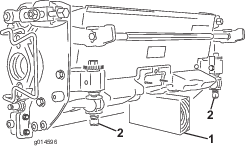
Installing the Cutting Units
-
Lift up on the footrest and swing it open, allowing access to the center cutting unit position (Figure 43).
Caution
The footrest can pinch fingers if it falls into the closed position.
Keep your fingers clear of the area where the footrest seats while it is open.
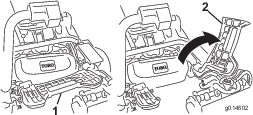
-
Position the cutting unit under the center suspension arm.
-
With the latches on the suspension-arm bar pointing up (i.e., open) (Figure 44), push the suspension arm down so that the bar fits over the bar across the top of the cutting unit (Figure 45).
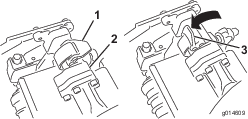
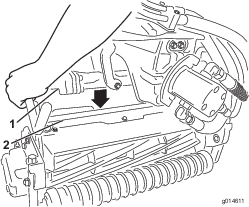
-
Close the latches down and around the cutting-unit bar and lock them in place (Figure 44).
Note: You can hear a click and feel when the latches are properly locked in place.
-
Coat the spline shaft of the cutting unit motor with clean grease (Figure 46).
-
Insert the motor into the left side of the cutting unit (as viewed from the operator's position) and pull the motor retaining bar on the cutting unit toward the motor until you hear a click from both sides of the motor (Figure 46).
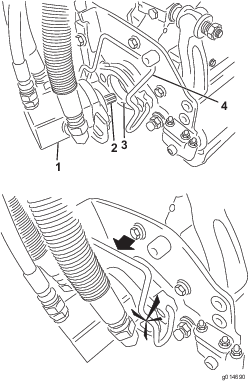
-
Mount a grass basket onto the basket hooks on the suspension arm.
-
Repeat this procedure for the other cutting units.
Removing the Cutting Units
-
Park the machine on a clean level surface, lower the cutting units to the ground until the suspension hydraulics are fully extended, shut off the engine, and set the parking brake.
-
Push the motor retaining bar out of the slots on the motor toward the cutting unit and remove the motor from the cutting unit.
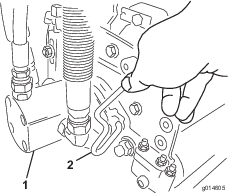
-
Move the motor to the storage location on the front of the suspension arm (Figure 48).
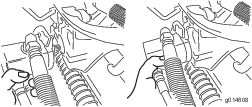
Note: When sharpening, setting the height-of-cut, or performing other maintenance procedures on the cutting units, store the cutting unit reel motors in the storage location on the front of the suspension arms to prevent damage to them.
Important: Do not raise the suspension to the transport position when the reel motors are in the holders in the machine frame. Damage to the motors or hoses could result. If you must move the traction unit without the cutting units installed, secure them to the suspension arms using cable ties.
-
Open the latches on the suspension-arm bar of the cutting unit you are removing (Figure 44).
-
Disconnect the latches from the cutting-unit bar.
-
Roll the cutting unit out from under the suspension arm.
-
Repeat steps 2 through 6 for the other cutting units as required.
Checking the Reel-to-Bedknife Contact
| Maintenance Service Interval | Maintenance Procedure |
|---|---|
| Before each use or daily |
|
Each day before operating the machine, check the reel-to-bedknife contact, regardless if the quality of cut had previously been acceptable. There must be light contact across the full length of the reel and bedknife; refer to the Cutting Unit Operator’s Manual.
Setting the Reel Speed
To achieve a consistent, high-quality cut and a uniform, after-cut appearance, you must correctly set the reel speed control (located on the manifold block under the cover to the left of the seat). Adjust the reel speed control as follows:
-
Select the height-of-cut at which the cutting units are set.
-
Choose the desired ground speed best suited for conditions.
-
Use the table that follows to determine the reel-speed setting for your 5-, 8-, 11-, or 14-blade cutting units. (Figure 49)
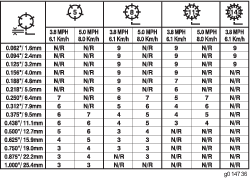
-
Adjust the reel speed by rotating the knob (Figure 50) until the indicator arrows are in line with the number you determined in step 3.

Note: You can increase or decrease the reel speed to compensate for turf conditions.
Backlapping the Reels
Warning
Contact with the reels or other moving parts can result in personal injury.
-
Keep your fingers, hands, and clothing away from the reels or other moving parts.
-
Never attempt to turn the reels by hand or foot while the engine is running.
-
Position the machine on a level surface, lower the cutting units, shut off the engine, and engage the parking brake.
-
Remove the plastic cover to the left side of the seat.
-
Make initial reel to bedknife adjustments appropriate for backlapping on all cutting units which are to be backlapped; refer to the Cutting Unit Operator’s Manual.
Danger
Changing the engine speed while backlapping may cause the reels to stall.
-
Never change the engine speed while backlapping.
-
Backlap only at idle engine speed.
-
-
Start the engine and run at low idle speed.
-
Rotate the backlap lever to the REVERSE (R) position (Figure 51).

-
Rotate the reel-speed control to setting 1 (Figure 52).

-
With the functional-control lever in the NEUTRAL position, move the raise/lower mow control forward to start the backlapping operation on the designated reels.
-
Apply lapping compound with a long handle brush. Never use a short handled brush.
-
If the reels stall or become erratic while backlapping, select a higher reel speed setting until the speed stabilizes, then return the reel speed to setting 1 or to your desired speed.
-
To make an adjustment to the cutting units while backlapping, turn the reels off by moving the raise/lower mow control rearward and shut off the engine. After completing adjustments, repeat steps 4 through 8.
-
Repeat the procedure for all cutting units you want to backlap.
-
When finished, return the backlap levers to the FORWARD (F) position, replace the cover, and wash all lapping compound off of the cutting units. Adjust cutting unit reel to bedknife as needed. Move the cutting unit reel speed control to the desired mowing position.
Important: If the backlap lever is not returned to the FORWARD (F) position after backlapping, the cutting units will not raise or function properly.
Diagnostics System
Diagnosing the Service Indicator Light
The service indicator light illuminates in the event of a fault in the machine. When this light is on, you can access the computer codes to diagnose the problem by entering diagnostic mode. In diagnostic mode, the service indicator light flashes a number of times, giving you the error code that you or your authorized Toro distributor can use to identify the problem.
Note: You cannot start the engine in diagnostic mode.
Entering Diagnostic Mode
-
Stop the machine, set the parking brake, and turn the ignition key to the OFF position.
-
Move the functional-control lever to the TRANSPORT position.
-
Ensure that the backlap lever is set to the FORWARD (F) position.
-
Get off the seat.
-
Hold the raise/lower mow control in the RAISED position.
-
Turn the ignition switch to the RUN position.
-
Count the codes as they begin to flash (you may release the raise/lower mow control once they begin flashing).
When finished, turn the key to the OFF position to exit diagnostic mode.
Determining the Error Code
The system will display the last 3 faults that occurred in the last 40 hours. It displays the faults through a series of blinking lights, as follows:
-
If there are no faults, the light will blink steadily at a medium rate without pauses (1 Hz).
-
If there is a fault, it will first blink the tens place, followed by a pause, followed by the ones place. For the following examples, a # represents a blink. Examples:
-
If the code is 15, the blink pattern will be #_#####
-
If the code is 42, the blink pattern will be ####_##
-
If the code is 123, the blink pattern will be ############_###
-
-
If there are more than 1 fault, the tens place of the next fault will begin after a pause after the ones place of the first fault.
Note: The system stores only the 3 most recent fault codes.
For a list of error codes, refer to your authorized Toro distributor or the Service Manual.
Storage
If you wish to store the machine for a long period of time, the following steps should be performed prior to storage:
-
Remove accumulations of dirt and old grass clippings. Sharpen the blades and bedknives, if necessary; refer to the cutting unit Operator's Manual. Use a rust preventive on bedknives and blades. Grease and oil all lubrication points.
-
Block up the wheels to remove any weight on the tires.
-
Drain and replace the hydraulic fluid and filter and inspect the hydraulic lines and fittings. Replace, if necessary; refer to Changing the Hydraulic Fluid and Filter and Checking the Hydraulic Lines and Hoses.
-
All fuel should be removed from the fuel tank. Run the engine until it stops from lack of fuel. Replace the fuel filter; refer to Replacing the Fuel Filter/Water Separator.
-
While the engine is still warm, drain the oil from the crankcase. Refill it with fresh oil; refer to Changing the Engine Oil and Filter.
-
Clean dirt and chaff from the cylinder, cylinder head fins, and blower housing.
-
Remove the battery and charge it fully. Either store it on the shelf or on the machine. Leave the cables disconnected if it is stored on the machine. Store the battery in a cool atmosphere to avoid quick deterioration of the charge in the battery.
-
If possible, store the machine in a warm, dry location.
